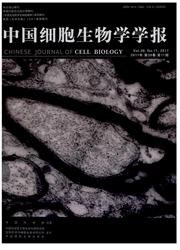

 中文摘要:
中文摘要:
骨髓源神经千细胞(bonemarrow—derived neural stem cells,BM—NSCs)具有自我更新和分化为神经元与神经胶质细胞的潜能,可用于修复治疗多种神经系统退变与损伤性疾病。但由于其表面缺乏趋化因子受体,移植后向中枢病变部位迁移的速度较慢,疗效欠佳。该研究构建了趋化因子受体CCR5基因,并转染BM—NSCs,用免疫荧光细胞化学法、流式细胞胞仪法及Boyden小室细胞趋化实验,体外研究了CCR5高表达对BM-NSCs增殖、分化与迁移能力的影响。结果表明,CCR5高表达能显著增强BM.NSCs~O趋化能力,而不影响其自我更新和分化为神经元与神经胶质细胞的能力,说明其植入体内后可保持细胞替代与神经修复作用,并能快速大量迁移到病灶部位,显著增强疗效。
 英文摘要:
英文摘要:
Bone marrow-derived neural stem cells (BM-NSCs) possess the self-renewal and neural dif- ferentiation potential, which can be used to repair a variety of nervous system degeneration and traumatic diseases. However, the rate of BM-NSCs migrate to the inflammatory sites was relatively slow and correlated with a moder- ately slow and limited clinical benefit. Lack of, or low expressing of particular chemokine receptors on NSCs could be an important factor underlying the slow migration of NSCs. To enhance the therapeutic effect of BM-NSCs, we constructed chemokine receptor CCR5 gene and transduced it into BM-NSCs, then assessed their capacity of pro- liferation, differentiation and migration with immunocytochemistry staining, flow cytometry and chemotaxis assay. It showed that overexpression of CCR5 enhanced chemotactic capacity of BM-NSCs significantly without affecting their ability of self-renew and differentiate into neurons and glial cells, indicating that gene-modified cells can not only maintain their potential of cell replacement and neural repair, but also possess rapid and mass migration to the lesion site, significantly enhance therapeutic efficacy.
 同期刊论文项目
同期刊论文项目
 同项目期刊论文
同项目期刊论文
 CCR5-Transduced Neural Stem Cells Confer Accelerated and Enhanced Therapeutic Effect on Experimental
CCR5-Transduced Neural Stem Cells Confer Accelerated and Enhanced Therapeutic Effect on Experimental Epoxyaurapten inhibition of smooth muscle contraction and phosphorylation of myosin light chain by m
Epoxyaurapten inhibition of smooth muscle contraction and phosphorylation of myosin light chain by m Osthole confers neuroprotection against cortical stab woundinjury and attenuates secondary brain inj
Osthole confers neuroprotection against cortical stab woundinjury and attenuates secondary brain inj Ostholepromotes neuronal differentiation and inhibits apoptosis via Wnt/β-cateninsignaling in an Alz
Ostholepromotes neuronal differentiation and inhibits apoptosis via Wnt/β-cateninsignaling in an Alz Osthole Augments Therapeutic Efficiency of Neural Stem Cells-Based Therapy in Experimental Autoimmun
Osthole Augments Therapeutic Efficiency of Neural Stem Cells-Based Therapy in Experimental Autoimmun Neuroprotective Effect of Arctigenin via Upregulation of P-CREB in Mouse Primary Neurons and Human S
Neuroprotective Effect of Arctigenin via Upregulation of P-CREB in Mouse Primary Neurons and Human S Neurotrophin 3 Transduction Augments Remyelinating and Immunomodulatory Capacity of Neural Stem Cell
Neurotrophin 3 Transduction Augments Remyelinating and Immunomodulatory Capacity of Neural Stem Cell The Coumarin Derivative Osthole Stimulates AdultNeural Stem Cells, Promotes Neurogenesis in the Hipp
The Coumarin Derivative Osthole Stimulates AdultNeural Stem Cells, Promotes Neurogenesis in the Hipp Accelerated and enhanced effect of CCR5-transduced bone marrow neural stem cells on autoimmune encep
Accelerated and enhanced effect of CCR5-transduced bone marrow neural stem cells on autoimmune encep Neuroprotective effect of arctigenin via upregulation of p-EREB in mouse primary neurons and human S
Neuroprotective effect of arctigenin via upregulation of p-EREB in mouse primary neurons and human S 期刊信息
期刊信息
